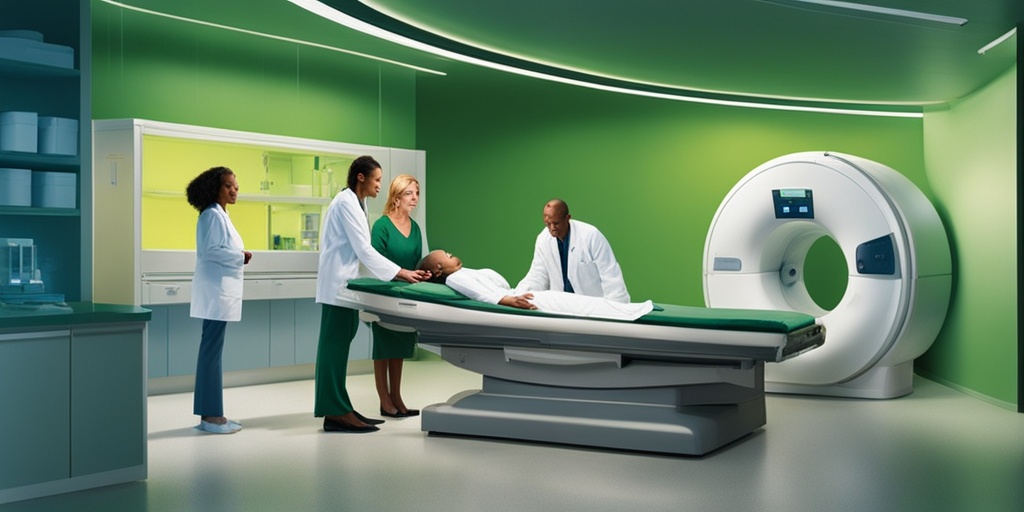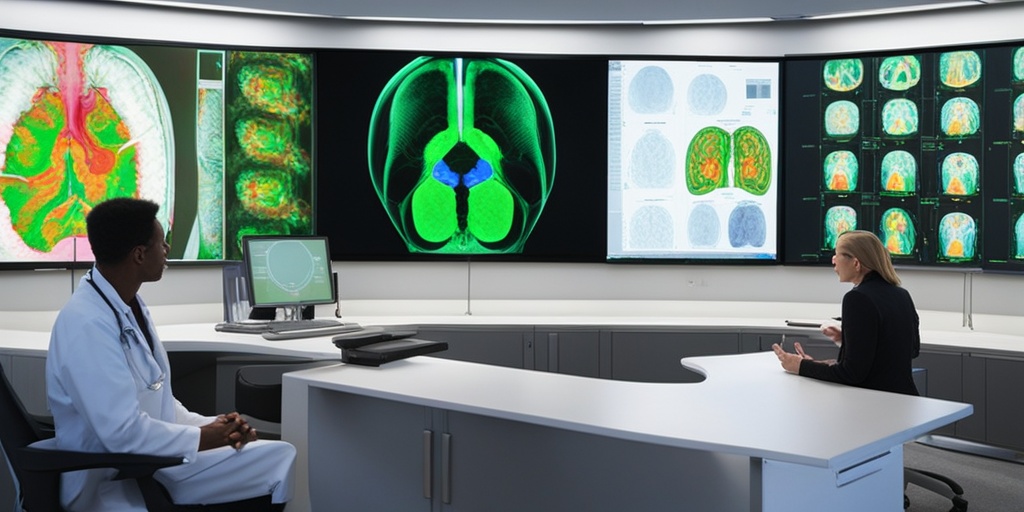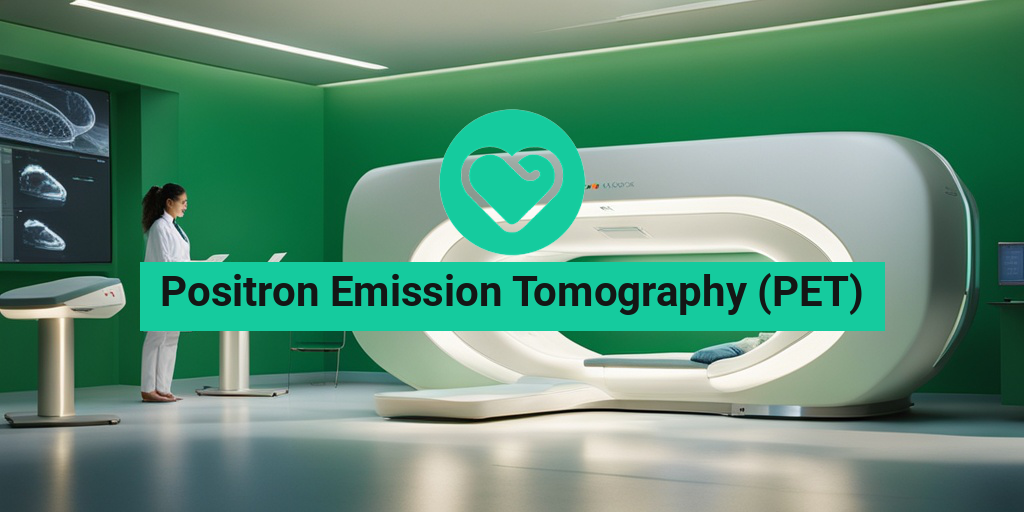“`html
What Is PET Imaging?
Positron Emission Tomography (PET) is a sophisticated imaging technique that allows healthcare professionals to observe metabolic processes in the body. Unlike traditional imaging methods such as X-rays or MRIs, which primarily focus on anatomical structures, PET imaging provides insights into how tissues and organs function. This makes it an invaluable tool in diagnosing and monitoring various medical conditions, particularly cancers, neurological disorders, and cardiovascular diseases.
The Basics of PET Imaging
At its core, PET imaging involves the use of a radioactive substance known as a radiotracer. This radiotracer is typically a form of glucose that emits positrons as it decays. When injected into the body, the radiotracer accumulates in areas of high metabolic activity, which are often indicative of disease. The PET scanner then detects these emissions and creates detailed 3D images that highlight areas of concern.
Applications of PET Imaging
PET imaging is widely used in various medical fields, including:
- Oncology: PET scans are crucial for detecting cancer, determining its stage, and evaluating treatment effectiveness.
- Neurology: This imaging technique helps in diagnosing conditions like Alzheimer’s disease, epilepsy, and other neurological disorders.
- Cardiology: PET scans can assess heart function and detect areas of reduced blood flow.
How PET Works
The process of a PET scan is both fascinating and intricate. Understanding how PET works can demystify this advanced imaging technique and highlight its importance in modern medicine.
The Role of Radiotracers
As mentioned earlier, radiotracers are the cornerstone of PET imaging. These substances are designed to mimic naturally occurring compounds in the body, such as glucose. When a patient undergoes a PET scan, they receive an injection of a radiotracer, which travels through the bloodstream and accumulates in areas of high metabolic activity. The most commonly used radiotracer is 18F-fluorodeoxyglucose (FDG), which is particularly effective in cancer detection.
Scanning Process
Once the radiotracer has been administered, the patient will lie down on a scanning bed that moves through a large, doughnut-shaped machine. The PET scanner detects the gamma rays emitted by the radiotracer as it decays. These emissions are then processed by a computer to create detailed images of the body’s internal structures and functions.
Interpreting PET Scan Results
After the scan, a radiologist will analyze the images to identify any areas of abnormal metabolic activity. For instance, in cancer patients, areas with high uptake of the radiotracer may indicate the presence of tumors. Conversely, low uptake in certain regions can suggest healthy tissue. The results of a PET scan can provide critical information for treatment planning and monitoring.
Benefits of PET Imaging
There are several advantages to using PET imaging:
- Early Detection: PET scans can detect diseases at an early stage, often before symptoms appear.
- Functional Information: Unlike other imaging techniques, PET provides functional information about tissues and organs, which is essential for accurate diagnosis.
- Comprehensive Assessment: PET scans can be combined with CT or MRI scans for a more comprehensive view of the patient’s condition.
In conclusion, Positron Emission Tomography (PET) is a powerful imaging tool that plays a crucial role in modern medicine. By providing insights into metabolic processes, PET scans help healthcare professionals make informed decisions about diagnosis and treatment. For more information on PET imaging and other health-related topics, consider visiting Yesil Health AI, a valuable resource for evidence-based health answers. 🌟
“`

“`html
Benefits of PET Scans
Positron Emission Tomography (PET) scans are a powerful diagnostic tool that offers numerous benefits in the field of medicine. By providing detailed images of metabolic processes in the body, PET scans play a crucial role in diagnosing and monitoring various health conditions. Here are some of the key benefits of PET scans:
1. Early Detection of Diseases
One of the most significant advantages of PET scans is their ability to detect diseases at an early stage. Unlike traditional imaging techniques, PET scans can identify changes in cellular activity, allowing for the early diagnosis of conditions such as cancer, heart disease, and neurological disorders. Early detection often leads to more effective treatment options and improved patient outcomes.
2. Comprehensive Imaging
PET scans provide a comprehensive view of the body’s metabolic activity. This is particularly beneficial for oncologists, as it helps them assess the presence and spread of tumors. The ability to visualize metabolic processes allows healthcare providers to make informed decisions regarding treatment plans.
3. Non-Invasive Procedure
Another advantage of PET scans is that they are non-invasive. Patients typically undergo the procedure without the need for surgery or other invasive techniques. This makes PET scans a safer option for many individuals, especially those who may be at higher risk for complications from invasive procedures.
4. Monitoring Treatment Effectiveness
PET scans are invaluable for monitoring the effectiveness of treatment. For patients undergoing chemotherapy or radiation therapy, PET scans can reveal how well the treatment is working by showing changes in metabolic activity within tumors. This information helps doctors adjust treatment plans as necessary, ensuring that patients receive the most effective care possible.
5. Research and Development
In addition to their clinical applications, PET scans are also a valuable research tool. They are used in various studies to explore brain function, drug efficacy, and the progression of diseases. The insights gained from PET imaging contribute to advancements in medical science and the development of new therapies.
Common Uses of PET
Positron Emission Tomography (PET) scans are utilized in a variety of medical fields due to their unique ability to visualize metabolic processes. Here are some of the most common uses of PET scans:
1. Oncology
PET scans are predominantly used in oncology to detect and monitor cancer. They help in:
- Identifying tumors: PET scans can reveal the presence of cancerous cells that may not be visible through other imaging techniques.
- Staging cancer: By assessing the extent of cancer spread, PET scans assist in determining the most appropriate treatment options.
- Evaluating treatment response: PET scans can show how well a tumor is responding to treatment, allowing for timely adjustments.
2. Neurology
In neurology, PET scans are used to evaluate brain function and diagnose conditions such as:
- Alzheimer’s disease: PET scans can detect amyloid plaques in the brain, which are indicative of Alzheimer’s.
- Seizure disorders: They help identify the origin of seizures by highlighting areas of abnormal brain activity.
- Parkinson’s disease: PET imaging can assess dopamine function, aiding in the diagnosis of Parkinson’s.
3. Cardiology
PET scans are also valuable in cardiology for assessing heart health. They can:
- Evaluate blood flow: PET scans can measure blood flow to the heart muscle, helping to identify areas of reduced blood supply.
- Assess heart function: They provide insights into how well the heart is pumping and can help diagnose conditions like coronary artery disease.
4. Infection and Inflammation
PET scans can be used to detect infections and inflammatory conditions. They help in:
- Identifying sites of infection: PET scans can pinpoint areas of increased metabolic activity associated with infections.
- Monitoring inflammatory diseases: Conditions like rheumatoid arthritis can be evaluated using PET imaging to assess disease activity.
In summary, Positron Emission Tomography (PET) scans are a versatile and powerful tool in modern medicine, offering numerous benefits and applications across various fields. Their ability to provide detailed insights into metabolic processes makes them invaluable for early disease detection, treatment monitoring, and ongoing research.
“`

“`html
PET Scan Preparation
Preparing for a Positron Emission Tomography (PET) scan is crucial for ensuring accurate results and a smooth experience. Here’s what you need to know to get ready for your appointment.
Understanding the Procedure
A PET scan is a non-invasive imaging test that helps doctors observe metabolic processes in the body. It uses a small amount of radioactive material, known as a radiotracer, which is injected into your bloodstream. This radiotracer emits positrons, allowing the scanner to create detailed images of your organs and tissues.
Pre-Scan Instructions
To ensure the best possible results, follow these preparation steps:
- Fasting: You may be required to fast for several hours before the scan. Typically, fasting for 4-6 hours is recommended, but always confirm with your healthcare provider.
- Medication: Inform your doctor about any medications you are taking. Some medications may need to be paused before the scan.
- Hydration: Drink plenty of water before the scan unless instructed otherwise. Staying hydrated can help with the imaging process.
- Clothing: Wear comfortable, loose-fitting clothing. Avoid wearing jewelry or clothing with metal, as these can interfere with the scan.
- Informing the Staff: Let the medical staff know if you are pregnant, breastfeeding, or have any allergies, especially to contrast materials.
What to Bring
On the day of your PET scan, make sure to bring:
- Your insurance information and identification.
- A list of your current medications.
- Any previous imaging results that may be relevant.
What to Expect During a PET Scan
Understanding what happens during a PET scan can help alleviate any anxiety you may have. Here’s a step-by-step guide to what you can expect during the procedure.
Arrival and Check-In
Upon arrival at the imaging center, you will check in and may need to fill out some paperwork. The staff will guide you through the process and answer any questions you might have.
Receiving the Radiotracer
Once you are ready, a healthcare professional will administer the radiotracer, usually through an injection in your arm. You might feel a slight pinch, similar to a regular blood draw. After the injection, you will need to wait for a short period (typically 30-60 minutes) to allow the radiotracer to circulate through your body.
The Scanning Process
When it’s time for the scan, you will lie down on a comfortable table that slides into the PET scanner. The scanner looks like a large donut, and it will take images of your body from different angles. Here’s what to expect:
- Duration: The actual scanning process usually takes about 20-40 minutes, depending on the area being examined.
- Staying Still: It’s important to remain as still as possible during the scan to ensure clear images. You may be asked to hold your breath briefly at certain points.
- Noise Levels: The scanner may make some noise, but it’s completely normal. You can relax and focus on your breathing.
Post-Scan Instructions
After the scan is complete, you can resume your normal activities. However, it’s advisable to drink plenty of fluids to help flush the radiotracer out of your system. Your doctor will discuss the results with you at a follow-up appointment.
In summary, being well-prepared for your Positron Emission Tomography (PET) scan can make the experience smoother and more comfortable. Understanding the process can help ease any concerns you may have. 😊
“`

“`html
Risks and Side Effects of PET
Positron Emission Tomography (PET) scans are invaluable tools in modern medicine, providing detailed images of metabolic processes in the body. However, like any medical procedure, they come with certain risks and side effects that patients should be aware of before undergoing the scan.
Radiation Exposure
One of the primary concerns associated with PET scans is radiation exposure. During a PET scan, a small amount of radioactive material, known as a radiotracer, is injected into the body. This radiotracer emits positrons, which are detected by the PET scanner to create images. While the amount of radiation is generally considered safe and is comparable to that of a CT scan, repeated exposure can increase the risk of developing cancer over time. It’s essential to discuss your medical history and any previous imaging tests with your healthcare provider to assess your individual risk.
Allergic Reactions
Although rare, some patients may experience allergic reactions to the radiotracer used in the PET scan. Symptoms can range from mild (such as itching or rash) to severe (such as difficulty breathing). If you have a history of allergies, particularly to contrast agents or radiotracers, be sure to inform your healthcare team prior to the procedure.
Discomfort During the Procedure
While a PET scan is generally painless, some patients may experience discomfort during the injection of the radiotracer or while lying still on the scanning table. If you have difficulty remaining still due to pain or anxiety, discuss this with your healthcare provider beforehand. They may offer solutions to help you feel more comfortable during the procedure.
Potential for False Positives
Another consideration is the possibility of false positives in PET scan results. This occurs when the scan indicates abnormal activity that is not related to cancer or other diseases. Factors such as inflammation, infection, or even recent physical activity can lead to misleading results. Therefore, it’s crucial to interpret PET scan results in conjunction with other diagnostic tests and clinical evaluations.
Interpreting PET Scan Results
Understanding the results of a Positron Emission Tomography (PET) scan can be complex, but it is essential for making informed decisions about your health. Here’s a breakdown of how to interpret these results effectively.
What PET Scan Results Show
PET scans primarily reveal metabolic activity in tissues and organs. Areas of high metabolic activity may indicate the presence of cancer, as malignant cells often consume more glucose than normal cells. Conversely, low metabolic activity can suggest healthy tissue or the absence of disease. However, interpreting these results requires a nuanced understanding of the underlying biology.
Understanding Standard Uptake Values (SUV)
One of the key metrics used in PET scans is the Standard Uptake Value (SUV). This value quantifies how much radiotracer is absorbed by a particular area of the body compared to the average uptake in the rest of the body. Higher SUV values can indicate increased metabolic activity, which may be associated with cancer. However, it’s important to note that SUV values can vary based on several factors, including the type of cancer, the timing of the scan, and the patient’s overall health.
Consulting with a Specialist
Interpreting PET scan results should always be done in consultation with a qualified healthcare professional, such as an oncologist or a radiologist. They can provide context for the findings and discuss how they relate to your overall health and treatment options. It’s also important to consider the results alongside other imaging studies, such as CT or MRI scans, and laboratory tests.
Follow-Up Testing
In some cases, a PET scan may not provide definitive answers, leading to the need for follow-up testing. This could include additional imaging studies, biopsies, or blood tests to clarify the diagnosis. Always discuss the next steps with your healthcare provider to ensure a comprehensive approach to your health.
In summary, while PET scans are powerful diagnostic tools, understanding their risks and interpreting the results requires careful consideration and professional guidance. If you have any concerns or questions about your PET scan, don’t hesitate to reach out to your healthcare team for support. 🩺
“`

“`html
Frequently Asked Questions about Positron Emission Tomography (PET)
What is Positron Emission Tomography (PET)?
Positron Emission Tomography (PET) is a medical imaging technique that allows doctors to observe metabolic processes in the body. It uses radioactive substances known as radiotracers to visualize how tissues and organs function.
How does a PET scan work?
A positron emission tomography (PET) scan works by injecting a small amount of radioactive material into the body. This material emits positrons, which collide with electrons, producing gamma rays. The PET scanner detects these rays and creates detailed images of the body’s internal processes.
What conditions can a PET scan help diagnose?
- Cancer detection and monitoring
- Heart disease assessment
- Brain disorders, including Alzheimer’s disease
- Evaluation of seizures
Are there any risks associated with PET scans?
While PET scans are generally safe, they do involve exposure to a small amount of radiation. Patients should discuss any concerns with their healthcare provider, especially if they are pregnant or breastfeeding.
What should I expect during a PET scan?
During a positron emission tomography (PET) scan, you will be asked to lie down on a table that slides into the scanner. The procedure typically takes about 30 minutes to an hour, and you may need to wait for the radiotracer to circulate in your body before the scan begins.
How do PET scans compare to other imaging techniques?
Unlike traditional imaging methods such as X-rays or CT scans, PET scans provide information about the metabolic activity of tissues, making them particularly useful for detecting cancer and assessing treatment effectiveness.
Can PET scans be used for research purposes?
Yes, positron emission tomography (PET) is a valuable research tool in various fields, including psychology and neuroscience. It helps researchers study brain functions and the effects of different treatments on metabolic activity.
How can I prepare for a PET scan?
Preparation for a PET scan may include fasting for several hours before the procedure and avoiding certain medications. Always follow your healthcare provider’s specific instructions to ensure accurate results.
What do the results of a PET scan show?
The results of a positron emission tomography (PET) scan can reveal areas of abnormal metabolic activity, which may indicate the presence of disease. Your doctor will discuss the findings with you and recommend any necessary follow-up actions.
“`




